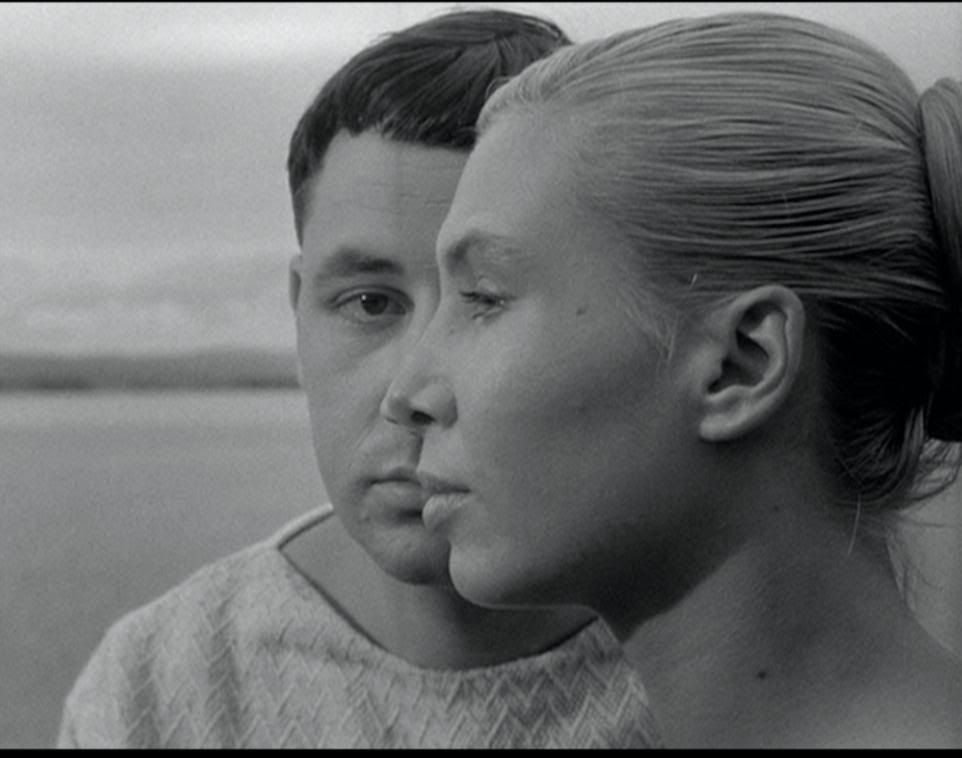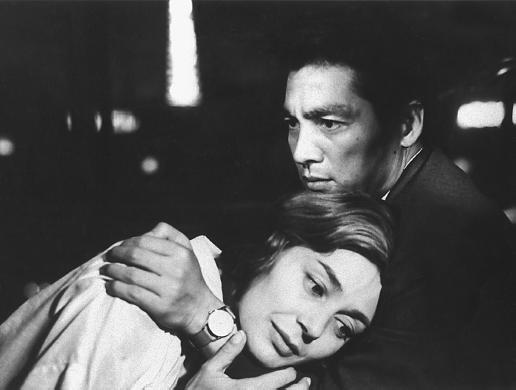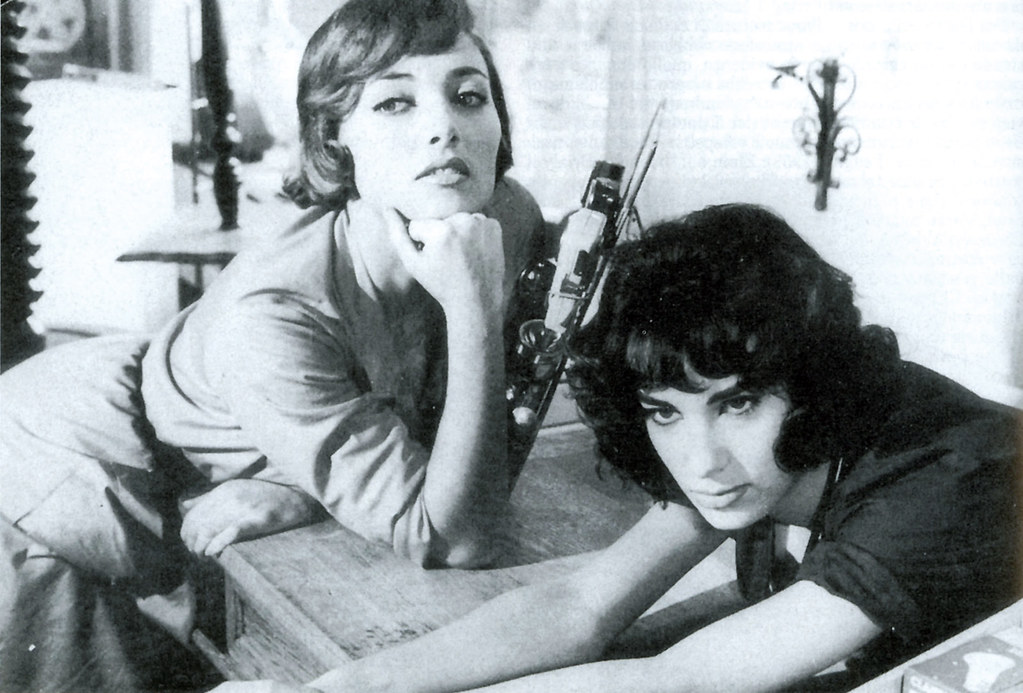Original due date: December 2nd, 2008
Pictures added for blogging purposes
I am not particularly proud of this paper. Maybe La Pointe Courte and Contempt bit though.
Some critics have said that the French New Wave should have been called a tidal wave. Spawning from the mid to late 1950s, the French New Wave developed a new type of filmic language reminiscent of Italian Neorealism.
 The young pioneers, François Truffaut, Jean-Luc Godard, Éric Rohmer, Claude Chabrol, and Jacques Rivette, started as critics contributing to the André Bazin founded Cahiers du Cinema, a critical film magazine. They had a profound admiration for Hollywood studio directors like John Ford, Alfred Hitchcock and Nicholas Ray and rejected the conventional style of modern French cinema. Through criticism and editorialization, they developed the auteur theory in that the director was the author of a film and applied this philosophy of filmmaking to themselves. But before these filmmakers really made their mark, a few noteworthy cineastes smoothed the way.
The young pioneers, François Truffaut, Jean-Luc Godard, Éric Rohmer, Claude Chabrol, and Jacques Rivette, started as critics contributing to the André Bazin founded Cahiers du Cinema, a critical film magazine. They had a profound admiration for Hollywood studio directors like John Ford, Alfred Hitchcock and Nicholas Ray and rejected the conventional style of modern French cinema. Through criticism and editorialization, they developed the auteur theory in that the director was the author of a film and applied this philosophy of filmmaking to themselves. But before these filmmakers really made their mark, a few noteworthy cineastes smoothed the way.Agnès Varda's first steps in film were directing La Pointe Courte (1954). Prior to this, she was completely ignorant of the cinema world and had only seen several films in her lifetime. What she lacked in knowledge of film, she made up in knowledge of photography. Since 1951, she worked as the official photographer at the Théâtre National Populaire and had a vast understanding of film compositions and aesthetic. Her ability and desire for more led her to enter the world of cinema.
Varda grew up near Sète and was familiar with the area, but when doing some photography in La Pointe Courte, a small fishing village just outside Sète, the idea for her first film came to her. "The tension between recording and creating reality, between the objective and the subjective, documentary and imaginative invention...was a problem that occurred to her" (Smith, 4). Still photography left too little to reaction and did not offer the dimension of time, especially the damage it causes and these thoughts led her to her first film. With less than 10% financing than other French films being produced at the same time, Varda set out to make La Pointe Courte using a cast of Silvia Monfort, Philippe Noiret and actual fishermen from La Pointe Courte, a mainstay of Italian Neorealism of which she was oblivious to. In order to stay on budget, the film was shot silent and sound was added in post and everyone was unpaid. Of the 10 million francs required to produce the film, only 7 million francs were made back and used to compensate the cast and crew according to Varda in an interview featured on Criterion Collection's DVD release. Under the reluctant aid of Alain Resnais, the film was edited together and invited by the critic André Bazin to screen at the 1955 Cannes Film Festival.
 It is undeniable that Varda produces stunning images. The mise-en-scène of each shot is structured and beautiful, especially the scenes with the couple which are recreated in Bergman's Persona (1966). The couple emotionlessly recites their lines over cuts of structured shots framing the two faces. As critic Alison Smith says, "Any still from these sequences supplies, first, a striking image where human figures are dramatically lit and arranged around intriguingly shaped marine debris, and secondly an image which has, in itself, a certain narrative content" (20). The cohesive ambiguity of these shots mimics the poetic dialogue between him and her, often skipping around over the central issue as to what they are going to do.
It is undeniable that Varda produces stunning images. The mise-en-scène of each shot is structured and beautiful, especially the scenes with the couple which are recreated in Bergman's Persona (1966). The couple emotionlessly recites their lines over cuts of structured shots framing the two faces. As critic Alison Smith says, "Any still from these sequences supplies, first, a striking image where human figures are dramatically lit and arranged around intriguingly shaped marine debris, and secondly an image which has, in itself, a certain narrative content" (20). The cohesive ambiguity of these shots mimics the poetic dialogue between him and her, often skipping around over the central issue as to what they are going to do.The chapters of the film are "jerky and uneven" (Varda, Criterion Interview), structured after William Faulkner's Wild Palms. Alternating between the fisherman and the couple, each chapter briefly touches upon the narrative then distances the viewer and cuts right back to the other story. This juxtaposition of scenarios highlights the clash between a private and social life not mixing. Authenticity and realism were principles Varda wished to portray. Quoted saying her interests lie in "the very premeditated and reconstructed aspects and the documentary style, real life, things caught in the moment" (Criterion Interview). Viewing a world through a subjective lens with a focus on the real thing is a two part movement in contemporary society. "One part conceptualizing and ordering the world and the other is accepting the world as it is...these shape the visual arts" (Criterion Interview). With these ideas and La Pointe Courte, Agnès Varda pioneered a new kind of cinema shot quickly, cheaply and naturally earning the name "Grandmother of the French New Wave" and moving on to make a more well-known French New Wave film Cleo from 5 to 7 (1962).
Alain Resnais' Hiroshima Mon Amour (1959) uses an innovative flashback technique often regarded as some of the best editing at the time, particularly the first 30 minutes of the film. Resnais considered himself a film editor first. The story follows a French woman visiting Hiroshima to film a movie.
 She meets and falls in love with a Japanese man and the two find relation in past horrific events, the bombing of Hiroshima and tragedies in Nevers. Resnais uses brief flashbacks sequences intercut in the present day story to suggest a brief flash of memory. Hiroshima Mon Amour was first going to be another short documentary, but when Resnais feared recreating his 1955 Holocaust documentary, Night and Fog, he seeked out Marguerite Duras to write a screenplay for him.
She meets and falls in love with a Japanese man and the two find relation in past horrific events, the bombing of Hiroshima and tragedies in Nevers. Resnais uses brief flashbacks sequences intercut in the present day story to suggest a brief flash of memory. Hiroshima Mon Amour was first going to be another short documentary, but when Resnais feared recreating his 1955 Holocaust documentary, Night and Fog, he seeked out Marguerite Duras to write a screenplay for him.It can easily be said that Hiroshima Mon Amour is a very difficult film due to its theme. Two lovers are drawn together and share past stories that bind them yet separate them at the same time. Hiroshima Mon Amour is an untangling of memories to say the least. Set against post-bombing Hiroshima, the film quickly sets the mood with ambiguous passionate embraces covered in presumed sweat and soot and then moves through memories of a city visited. The French woman shares her memories with the Japanese man and he only accepts that she understands nothing. John Ward puts it that "the girl only knows Hiroshima as a public event...she is an intruder into his tragedy" (18). Just as he only savors the beauty of the French word Nevers, neither can understand the horrors that the other has experienced.
This separation of the characters is documented at the cafe when both sit at different tables and are only able to stare at each other even while she is being hit on by a suave Japanese man. There is no speaking between him and her and only the sound of water fills the track. This water represents the rain to him which is a fear of those in Hiroshima since the bomb, whereas the water to her represents the Loire River and the ties to a past love affair with a German. Again, this separation is emphasized in the train station when an old Japanese woman sits between the French woman and the Japanese man. She is speechless, alone with her thoughts while he is conversing in Japanese with the old woman. The conversation is in Japanese and she cannot understand it.
Hiroshima Mon Amour might not directly belong to the French New Wave, but it is certainly influential enough to have been a part of it. Its innovative style and structure influenced many of the most prolific directors to the French New Wave. These filmmakers admire the film and have celebrated its originality.
Claude Chabrol was the most copious contributor to the French New Wave making almost one film a year. He is labeled as the most mainstream director of the New Wave since his Hitchcockian debut, Le Beau Serge (1958). His most personal film, Les Bonnes Femmes (1960) "is one of the most striking and successful manifestations of a central unifying feature of the early New Wave...: the tension between the stylised and the naturalistic, the formal and the documentary" (Wood, 39). The film's Parisian world may be highly consciously constructed but it always relates back to the real world.
 Released the same year as Godard's Breathless and Truffaut's Shoot the Piano Player, Les Bonnes Femmes easily lost some attention it deserved. The film follows four Parisian shop girls looking to escape their monotonous daily routine. Each has a distinct personality, thus, each receives a different episode to the film. These episodes and the girls are joined by a central theme. According to Robin Wood, "the theme that unifies the film is the discrepancy between dream and reality, the inability of the girls' environment to provide a means of realising their undefined yearnings" (43). Each girl yearns for a different life; Jane only wishes for a good time, Ginette dreams of being an Italian singer, Rita wishes for social advancement through her bourgeois husband, and Jacqueline awaits an anonymous motorcycle riding lover. The girls' desires continually increase in sensitivity and increase the chances of pain all the way to Jacqueline's desire for true romantic love. French audiences had to dig a little but there was a relatable reality hidden here.
Released the same year as Godard's Breathless and Truffaut's Shoot the Piano Player, Les Bonnes Femmes easily lost some attention it deserved. The film follows four Parisian shop girls looking to escape their monotonous daily routine. Each has a distinct personality, thus, each receives a different episode to the film. These episodes and the girls are joined by a central theme. According to Robin Wood, "the theme that unifies the film is the discrepancy between dream and reality, the inability of the girls' environment to provide a means of realising their undefined yearnings" (43). Each girl yearns for a different life; Jane only wishes for a good time, Ginette dreams of being an Italian singer, Rita wishes for social advancement through her bourgeois husband, and Jacqueline awaits an anonymous motorcycle riding lover. The girls' desires continually increase in sensitivity and increase the chances of pain all the way to Jacqueline's desire for true romantic love. French audiences had to dig a little but there was a relatable reality hidden here.Truffaut's career in film began, similar to that of other popular French New Wave directors, as a critic. His essays were published in many journals and magazines most notably Cahiers du Cinema. Early on he fell in love with US cinema and directors like Howard Hawks and Alfred Hitchcock and began to develop the auteur theory. In a denouncement to French cinema of the day, he set out to create a new type of film in the footsteps of Agnès Varda, Alain Resnais and other similar directors.
 Francois Truffaut's Jules and Jim (1962) was a staple to the French New Wave. It incorporated newsreel footage, stills, freeze frames, panning shots, dolly shots, lightweight camera equipment and a voice over narration. Raoul Coutard, who frequently shot Godard's films as well, worked the cinematography and was behind the fluidity of the shots even using bicycles during the postwar scenes. Like his first film, The 400 Blows (1959), Jules and Jim was a major critical and popular success. Audiences accepted the style of the French New Wave. "[The films] spoke intimately and directly to the emotions of their audiences and were exuberant and exciting in their technical virtuosity" (Monaco, 38).
Francois Truffaut's Jules and Jim (1962) was a staple to the French New Wave. It incorporated newsreel footage, stills, freeze frames, panning shots, dolly shots, lightweight camera equipment and a voice over narration. Raoul Coutard, who frequently shot Godard's films as well, worked the cinematography and was behind the fluidity of the shots even using bicycles during the postwar scenes. Like his first film, The 400 Blows (1959), Jules and Jim was a major critical and popular success. Audiences accepted the style of the French New Wave. "[The films] spoke intimately and directly to the emotions of their audiences and were exuberant and exciting in their technical virtuosity" (Monaco, 38).Jean-Luc Godard had a prolific career in the French New Wave. His film Breathless (1960) started it all. Contempt (1963) was Godard's most expensive and probably most accessible film. This film is capable of holding up in any era of film and this is due to its imagery of classical mythology. A screenwriter struggles to adapt Homer's epic, The Odyssey, for a demanding American producer and director Fritz Lang while handling his wife falling out of love with him. The film uses an at-the-time radical widescreen format and vivid coloring which does wonders throughout the film, but especially towards the end on the Mediterranean locations. Adapted from an Alberto Moravia novel, Godard created a beautiful story of marital problems and commercial filmmaking full of artistic merit.
Like many Godard films, Contempt boasts a lengthy domestic dispute. Raoul Coutard, the cinematographer, and Godard collaborate to make wonderful use of the cinematic space in the couple's apartment flat. "Space was an issue," (Criterion Interview) said Coutard in an interview but the resulting images are spectacular. Often times, the characters are calling off to each other in different rooms emphasizing the distance and separation between them that is present in their conversation. Likewise, when the two are in frame, "the discord between Paul and Camille is further stressed by the fact that they are repeatedly separated within the frame by doors, partition walls and objects of furniture" (Morrey, 16).
 Furthermore, Godard innovates again with a scene in which the two are separated by a lamp and the camera continually pans back and forth between the two's conversation to create one of division and contempt.
Furthermore, Godard innovates again with a scene in which the two are separated by a lamp and the camera continually pans back and forth between the two's conversation to create one of division and contempt."Contempt is an exercise in cinematic metaphor - specifically, Hollywood" (134) said James Monaco. Contempt looks at the relationships in filmmaking between the director, producer, screenwriter and even the film itself. At the end of the credits, as the tracking camera turns towards us, the audience, Godard gives us a quote from André Bazin: "The cinema gives us a substitute world which fits our desires." Following this and personifying it, Paul and Camille, who is naked, lay in bed and are shot through red and blue filters. "What Godard and Lang are going to give us is something quite different: not a substitute world but a real cinema, not a reflection of our desires but a challenge to our intellects" (Monaco, 135). This is what fascinated the French New Wave auteurs and Godard was able to address this relationship to film.
The French New Wave addressed a new generation of filmmaking. It looked at modern cinema and was able to analyze and adapt to form this new filmic language while simultaneously forming critical theories. Social and political upheavals were regular as was the break from convention in editing, style and the narrative. Just as earlier auteurs have influenced the French New Wave artists, the French New Wave has continued to influence the world of cinema.
______________________________________________________________________________
Coutard, Raoul. "Interview on Contempt DVD." 2002 The Criterion Collection.
Monaco, James. The New Wave. New York: Oxford UP, 1976.
Morrey, Douglas. Jean-Luc Godard. Manchester: Manchester UP, 2005.
Resnais, Alain. "Interview on Hiroshima Mon Amour DVD." 2003 The Criterion Collection.
Smith, Alison. Agnès Varda. Manchester: Manchester UP, 1998.
Ward, John. Alain Resnais. New York: Doubleday & Company Inc. 1968.
Wood, Robin and Michael Walker. Claude Chabrol. New York: Praeger Publishers, 1970.



